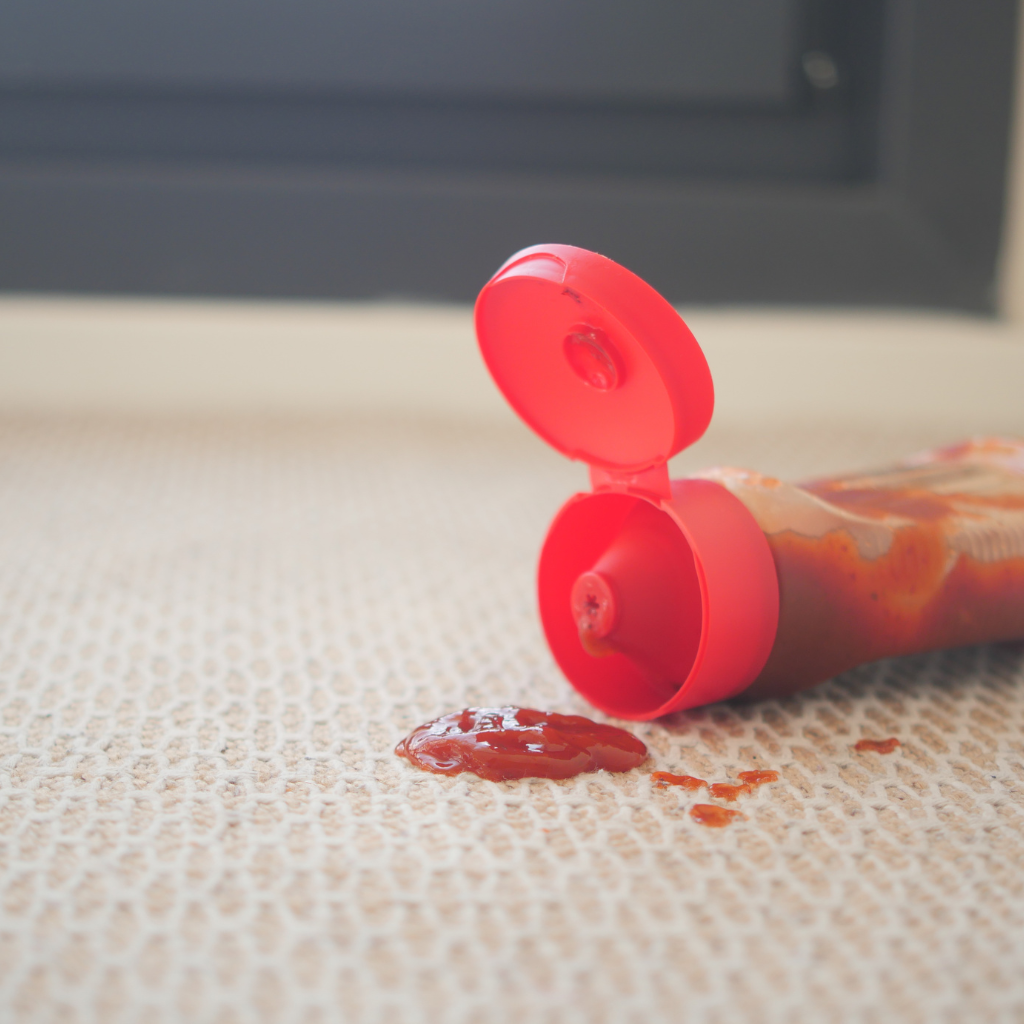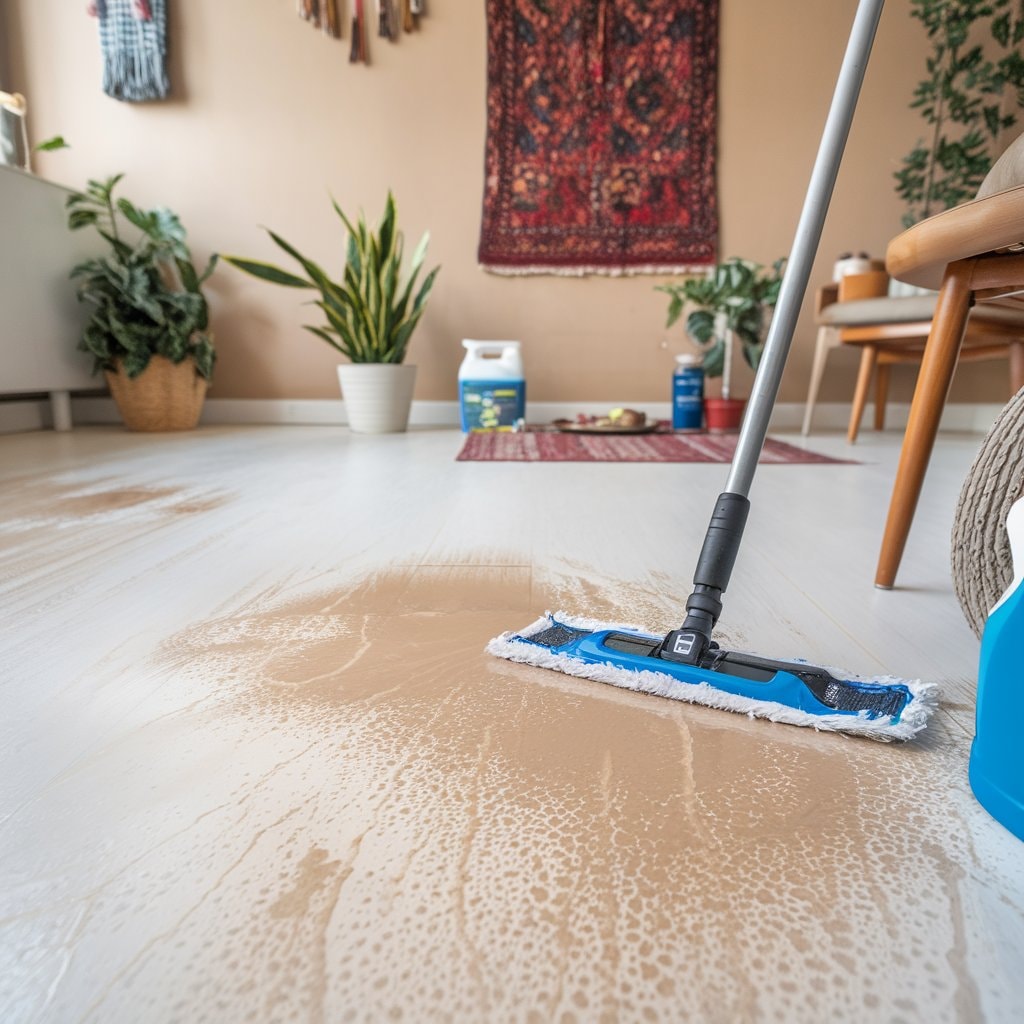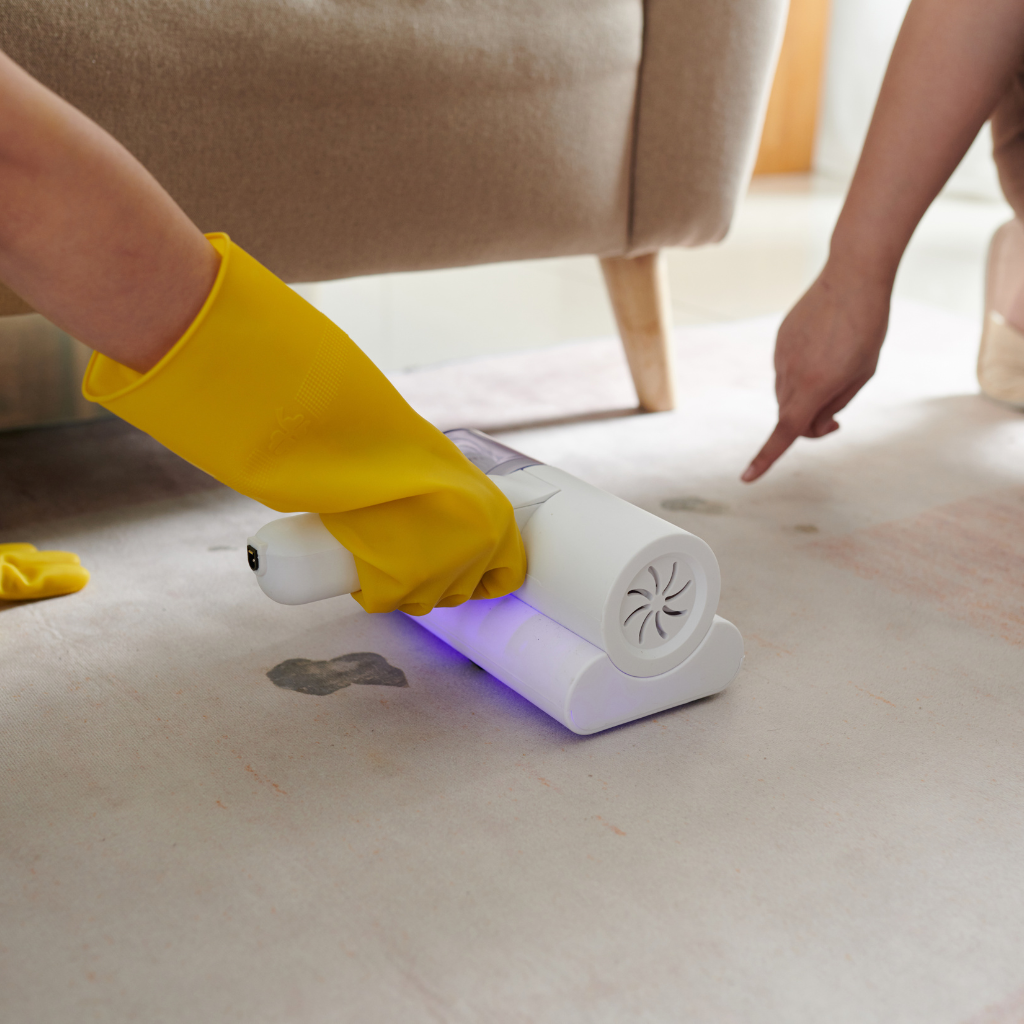Finding the right way to get stains out of vinyl flooring can often appear challenging. Many homeowners need help with maintaining their vinyl floors clear of persistent stains and marks, which can lessen the appeal of their homes.
This article aims to simplify the process of eradicating common stains from vinyl flooring, offering practical guidance on how to get stains out of vinyl flooring, ensuring your floors remain immaculate.
With years of expertise in delivering top-notch flooring solutions straight to customers' doors, our family-owned enterprise recognises the significance of keeping flawless floors.
We excel in addressing stubborn stains on different types of flooring, including luxury vinyl tiles. Prepare for easy-to-follow tips and tricks that will revolutionise your perception of floor cleaning.
To remove stains from vinyl flooring effectively, homeowners should start by identifying the type of stain. For common spills like wine or ink, Using a combination of warm water and dishwashing liquid works well.
Directly apply this solution to the stained area and lightly scrub it with a soft cloth to lift the stain. If the spill is oil-based, adding a few drops of vinegar to your cleaning mixture can help break down the grease.
Always rinse the area with clean water and dry it thoroughly to avoid any residue.
For tougher stains, such as nail polish or paint, rubbing alcohol may be necessary for spot treatment. Homeowners should apply a small amount onto a clean cloth and dab at the stain carefully until it starts to fade.
Avoid scrubbing too aggressively, as it can damage the vinyl's surface. After removing stubborn marks, mop the floor with a commercial vinyl floor cleaner diluted in water for an overall shine and finish off by rinsing with clean water and drying completely.
Keeping your vinyl floors in top condition requires quick action on spills and regular maintenance using these simple yet effective methods.
Removing stains from vinyl flooring requires effective methods and the right approach. Achieving a clean vinyl floor can enhance its appearance and prolong its life. Follow these steps to remove stains efficiently:
For luxury vinyl floors, avoid harsh chemicals such as bleach or acetone, which can discolour or damage the surface. Opt for pH-neutral floor cleaners specifically designed for vinyl flooring to maintain its shine and prevent any future stains.
Adding these steps to your cleaning routine can keep your vinyl floors looking new, preserving their quality without needing replacements due to staining mishaps. Always test cleaning solutions on a small, discreet area first to ensure they do not harm your specific type of vinyl flooring.
Vinyl flooring is effortless to clean and maintain, making it a favoured option for busy households. Removing common stains from your vinyl flooring requires some simple steps and household items.
Moving onto luxury vinyl floors requires slightly different care practices due to their unique composition and finish.
Removing stains from vinyl flooring requires the right tools and techniques. While most people focus on cleaners and cloths, don’t overlook the role of a proper vinyl flooring underlay, which can provide added support and moisture resistance, helping prevent certain stains from developing in the first place. Here's a list of essential items to help you tackle those stubborn marks effectively.
Armed with these tools, tackling stains on your vinyl flooring will become much simpler, leaving your floors looking their best with minimal effort.
Luxury vinyl flooring is a highly sought-after option for kitchens and bathrooms because it combines durability with an attractive appearance. It’s also an ideal alternative for those looking to replicate classic aesthetics—such as Victorian Tile Floors—while benefiting from the easy maintenance of modern materials.
To remove stains from your luxury vinyl floor, start by gently dabbing the area with a damp mop soaked in water mixed with mild washing-up liquid.
Avoid using abrasive scrubbers, as they can scratch the surface of the vinyl. For tougher stains, such as juice or cosmetics For stains, combine baking soda and water to create a paste. Apply the mixture to the stain and let it sit for a few minutes before wiping it away with a soft cloth.
This method is effective at lifting stubborn stains without harming the vinyl’s finish.
For spills involving grease or oil, rubbing alcohol can be used as a spot treatment to break down the fats and make them easier to wipe away. Always test any cleaning solution on an inconspicuous area first to ensure it won't damage your flooring.
Addressing spills and stains quickly prevents them from setting into your luxury vinyl, making maintenance easier over time. Using rugs in high-traffic areas also helps protect your floors from potential staining incidents, keeping them looking clean and pristine longer.

Removing stains from vinyl flooring can be difficult, but with the correct method, you can keep your floors looking as good as new. Here are some tried and tested ways to tackle those stubborn marks.
Using these methods ensures your vinyl flooring remains stain-free and well-maintained for years to come.
Transitioning from basic practices to more advanced guidance, we shall investigate professional methods for eradicating stains from premium vinyl. Specialists propose timely responses to prevent blemishes from penetrating your premium vinyl flooring.
In the event of a spill, clean it promptly with a plush cloth or mop. For more resistant spots like grease or makeup, utilising a mixture of warm water and mild cleaning agents can be remarkably effective.
Spread the solution tenderly onto the stain with a plush cloth and rub in a circular pattern until the stain dissipates.
It's always good practice to test cleaning solutions on a less visible area of your vinyl flooring before confronting the actual stain.
For headstrong marks that persist in staying, using baking soda combined into a paste with water can prove to be efficient. Lay this paste over the stain, let it stand for 10-15 minutes, then rinse off with warm water and pat dry thoroughly.
This method is mild enough not to harm your flooring but powerful against harsh blemishes. Keep in mind that it's best to avoid abrasive brushes as they could scratch or damage the surface of your opulent floors.
Transitioning from professional guidance to functional household solutions, baking soda emerges as a vital companion in eliminating stains on vinyl. This domestic hero provides an environmentally considerate and economical strategy to address those stubborn marks which compromise the aesthetic of your flooring.
This straightforward approach uses objects typically available in residences, demonstrating that efficient stain removal only sometimes necessitates specific commercial items. Baking soda, known in scientific terms as sodium bicarbonate, is particularly potent against grease (lubricant) and beverage spills, which are frequent perpetrators of vinyl flooring stains. Its slight abrasive features and natural odour neutralising ability position it as an outstanding choice for preserving immaculate floors without inflicting damage or utilising severe chemicals.
Addressing spills and stains rapidly with these commonplace objects will keep your vinyl floors appearing fresh and also increase their lifespan, resulting in monetary savings over time due to avoiding potential replacements or professional cleaning from paid weekly flooring services.
Selecting an optimal vinyl floor cleaner is vital for upkeeping your floors. A homemade cleaning concoction can be highly effective. Combine water with some gentle washing-up liquid and apply it carefully to the floor using a mop.
Please refrain from using strong chemicals as they can harm the surface of vinyl, rendering it listless and unattractive.
Post cleaning with the soap-filled solution, cleanse the floor with pure water. This final phase guarantees no soap remnants linger, possibly attracting further dirt in the long run.
Consistently cleaning your vinyl floors prolongs their life while maintaining their pristine and refreshed look.
Selecting the right product for cleansing vinyl floors is key to preserving their visual appeal and durability. Many homeowners opt for a gentle soap in warm water for everyday cleaning tasks.
This concoction effectively eradicates grime without leaving harmful residues that could become detrimental to the vinyl over time. For more stubborn stains, dedicated cleaners explicitly conceived for vinyl floors can address resistant blemishes without endangering the surface.
Select a cleaning solution that is approved for vinyl use, as aggressive substances can lead to permanent harm.
Utilising the appropriate cleaning solution keeps your vinyl flooring in an immaculate condition. Also, it prolongs its lifespan, assuring you receive complete value from your expenditure on high-quality flooring solutions.
It is essential to scrutinise product labels diligently to confirm their compatibility with your vinyl variant. This basic precaution helps ward off expensive errors and ensures your floors remain spotless and cheerful.
Creating a DIY cleaning solution for vinyl flooring is economical and straightforward. This method keeps your floors radiant, as well as preserving them from the potential harm of harsh chemicals.
This method provides an affordable solution to keep vinyl floors clean and free from stains using readily available household items.
After crafting your DIY cleaning solution for vinyl, the next step is rinsing with clean water. This ensures your floors remain spotless and free from any residue that could attract dirt.
Begin by mopping up the solution thoroughly. Use fresh, clean water to wipe over the area you've just cleaned.
Rinsing plays a crucial role in keeping your vinyl flooring in top condition. It removes any leftover cleaning agents. If these substances stay on the floor, they can make it sticky and more prone to gathering dust and grime.
Always use a well-wrung mop for this task to prevent too much water from sitting on your vinyl floors, as it could seep into seams and edges, leading to damage.

Identifying and treating resistant stains on vinyl necessitates a careful procedure. For persistent marks, use rubbing alcohol directly on the stain and softly rub. This strategy effectively removes spots from ink, lipstick, or markers.
If food spills, like dried tomato sauce, is a concern on your vinyl flooring, create a mixture of baking soda and water. Use this blend on the stained part and allow it to rest for 10-15 minutes before removing it with a damp cloth.
These processes remove challenging stains without causing harm to the vinyl surface.
For immediate stain remediation, rubbing alcohol is my preferred remedy; it efficiently removes a variety of inks and cosmetics shared by a seasoned flooring fitter.
Using readily available household items can be an effective way of keeping your floors in top condition while saving money. Make sure to try any cleaning solutions on a less noticeable part of your flooring first to prevent any damage or discolouration.
Regular cleaning of your vinyl floor extends its lifespan and preserves its aesthetic appeal without necessitating early replacement of your vinyl.
Identifying and treating tough stains on vinyl requires patience and the right approach. Here are the steps to tackle those stubborn marks effectively.
Tackling tough spots promptly and maintaining your vinyl floors will keep them looking their best for years to come.
Rubbing alcohol proves to be an effective spot treatment for removing tricky stains from vinyl flooring. Apply a small amount directly to the stain and gently rub it with a soft cloth.
This method works well for marks that are difficult to remove, such as ink or makeup. People should avoid using rubbing alcohol on laminate flooring as it might damage the surface.
Next, food stains like tomato sauce pose a different challenge on vinyl floors.
To tackle food stains such as tomato sauce on vinyl, start by gently scraping off any solid residue with a plastic spoon or spatula. This ensures you don't scratch the vinyl flooring.
Next, combine warm water with a mild detergent solution washing-up liquid, in a bowl. Using a soft cloth, dab the stained area with this mixture to break down the stain. Avoid scrubbing too hard, as it can damage the floor's surface.
For persistent stains, make a paste with Mix baking soda and water to form a paste, then apply it directly to the stain. Leave it for ten minutes before wiping it away with a damp cloth. Baking soda works as a soft abrasive that helps remove stubborn food stains without harming your vinyl flooring.
Rinse the area with clean water to remove any remaining cleaning residue. These steps help maintain your vinyl floors' appearance without needing costly replacements or professional services.
Preventing stains on your vinyl flooring begins with routine maintenance and quick action. Always clean spills as soon as they occur to avoid any stain from setting onto your vinyl floor.
Regular sweeping or vacuuming keeps the surface clear of dirt and debris that could scratch the surface, which makes it easier for stains to penetrate. For homeowners and builders alike, employing rugs and mats in high-traffic areas or near entrances can significantly reduce the amount of dirt coming into contact with the floor.
Maintaining clean vinyl floors is simpler than you think; it starts with handling spills quickly.
Moreover, using felt pads under furniture legs helps in avoiding scuffs and marks that can lead to staining over time. For interior designers focusing on longevity, recommending clients choose a quality polyvinyl chloride (PVC) flooring option ensures resilience against staining compared to cheaper alternatives.
Following these steps effectively reduces the risk of staining, keeping your vinyl flooring looking pristine for longer without the need for frequent deep cleans or replacing your vinyl due to irreversible damage.
Maintaining clean vinyl floors ensures they remain in top condition and prolong their lifespan. Here are some best practices to keep your vinyl flooring clean and free from stains:
Following these steps helps ensure your vinyl floors stay looking their best for years to come.
Moving on, let's explore how to specifically tackle stubborn stains that might still find their way onto your floors despite your best efforts at prevention.
Handling spills and stains on vinyl flooring requires quick and effective methods to prevent lasting damage. The moment a spill occurs, one should wipe it up right away with a clean cloth or paper towel.
This prevents the spill from seeping into edges or seams, where it can be trickier to remove later. For stains that have already set in, applying a mixture of water and mild detergent directly to the stain can help lift it without harming the vinyl's surface.
Always test any cleaning solution test it on an inconspicuous area first to ensure it doesn't affect the colour or texture of your flooring.
For tougher stains, such as those from drinks, fruit, or ink, using specific cleaners like rubbing alcohol (ethanol) may be necessary. Dabbing a small amount onto a cloth and gently rubbing the stained area can break down these substances effectively.
It is crucial not to pour cleaning agents directly onto your floor but instead apply them to your cleaning tool of choice. This approach helps protect both the aesthetic appearance and structural integrity of your luxury vinyl floor over time while ensuring stain removal is successful.

After promptly addressing spills and stains, it's sensible to consider their prevention. Rugs and mats are essential in this process. They serve as a shield between your vinyl flooring and potential harm.
Locating them in areas with high footfall, such as entryways, corridors, and around furniture, can drastically minimise wear and tear. This approach maintains the floor's cleanliness and also extends its lifespan.
Rugs and mats prove particularly beneficial in locations likely to be affected by moisture and dirt buildup. By soaking up the majority of the immediate impact from footfall, they ensure that your vinyl retains its immaculate condition for an extended duration.
It's a simple yet efficient method to protect against unexpected spills or stains impacting the flooring's cost. Be sure to seek out rugs with non-dyed backing materials to prevent colour bleed onto your vinyl floor.
Preserving your vinyl sheet flooring with rugs and mats is crucial in keeping its appearance. This method reduces the likelihood of stubborn stains that can be challenging to clean. Consistent cleanliness enhances the overall aesthetics of your home and prolongs the lifespan of the flooring, ensuring a worthwhile investment.
Homeowners, interior designers, decorators, builders, and contractors need to adopt such cleanliness habits. Routine maintenance averts the establishment of obstinate stains, thereby simplifying the management of accidental spills or dirt.
Adopting this guide maintains the pristine condition of vinyl flooring and also economises time and energy in long-term care.